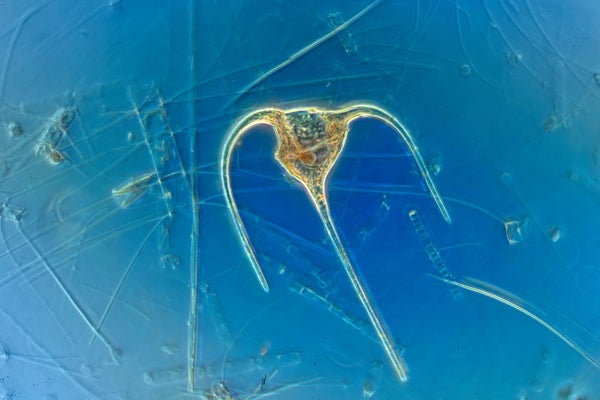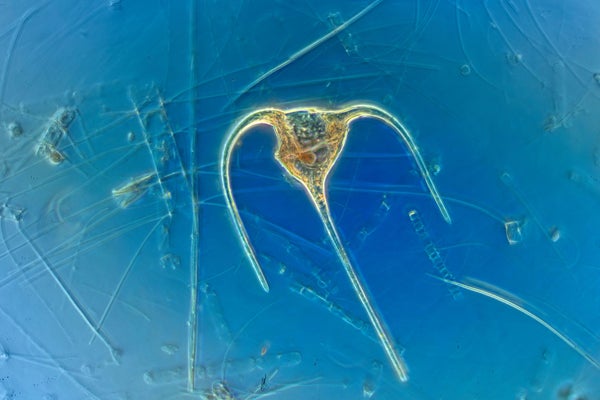Neither Plants nor Animals, These Ocean Organisms Protect Their Ecosystems against Heat Waves
Mixotrophs, which have characteristics of both animals and plants, could help blunt the effects of marine heat waves on ocean ecosystems

Micrograph of marine phytoplankton.
Scenics & Science/Alamy Stock Photo
For almost two years beginning in 2014, the waters along North America’s Pacific Coast endured the largest and longest-lasting marine heat wave ever recorded. Many species were devastated by ocean temperatures up to 2.4 degrees Celsius (4.3 degrees Fahrenheit) higher than normal. Kelp forests off northern California declined by more than 90 percent, an estimated million or more seabirds died, and fisheries closed up and down the coast, costing some fishing communities hundreds of millions of dollars. But one unassuming group of organisms managed to weather the unrelenting heat fairly well—by breaking the rules of biological separation between animals and plants.
Now new research suggests the flexible lifestyle of these organisms could make them crucial to the survival of ocean ecosystems as climate change continues to crank up the heat.
One of the first things many people learn in biology class is that a basic line can be drawn between two of Earth’s main kinds of life. On one side there are the autotrophs, such as plants, which mostly use photosynthesis to make food out of air, water and minerals, using energy they get from light. On the other are heterotrophs, such as animals, which cannot photosynthesize and so must eat other organisms to get energy. That division is a useful starting point—but like any simplified narrative, it leaves out a lot. All over the world there are organisms called mixotrophs that combine both of these strategies.
On supporting science journalism
If you’re enjoying this article, consider supporting our award-winning journalism by subscribing. By purchasing a subscription you are helping to ensure the future of impactful stories about the discoveries and ideas shaping our world today.
Various species of mixotrophs form a big part of oceanic plankton and are vital to marine food webs. Mixotrophic plankton such as ciliates and dinoflagellates can get energy by consuming some of the smallest single-celled plankton, which are too tiny to be efficiently used as food by larger species. These mixotrophs can reap the benefits of both photosynthesis and consumption of prey. Some are natural photosynthesizers that supplement that energy by eating, whereas others can integrate photosynthesizing phytoplankton into their own bodies. The mixotrophs are in turn eaten by larger plankton species such as copepods and krill, which then become prey for many fish, seabirds and marine mammals.
The new study, published recently in Aquatic Microbial Ecology, found that mixotrophic species made up a larger percentage of the plankton in the Gulf of Alaska during two major heat waves (from 2014 to 2016 and in 2019) than in years with average ocean temperatures. And even among the mixotrophs, the more generalist species—those able to feed on and form relationships with a wider range of phytoplankton—survived the heat waves better than more specialized ones. “Having more than one way to live in your back pocket is probably extremely advantageous in a highly variable environment,” says Suzanne Strom, senior marine scientist at Western Washington University and the paper’s lead author.
The study shows that these adaptable mixotrophs can be vital to the entire Gulf of Alaska ecosystem in heat wave years because they help to mediate a major consequence of marine warming: increased stratification, or the separation of ocean water into distinct layers. This effect can prevent the mixing of nutrients that would otherwise fuel robust aquatic ecosystems. Especially amid relatively long-lasting heat waves, stratified waters can lead to large phytoplankton blooms by trapping nutrients at the surface. Once those nutrients are eaten, the blooms dissipate, leaving an area of depleted oxygen, and the stratification prevents more nutrients from rising to the surface to restart the cycle. This can cause die-offs among fish and other species.
“That’s when the mixotrophs really become important in that system,” says Diane Stoecker, a professor emerita at the University of Maryland’s Center for Environmental Science, who was not involved in the recent paper. These organisms’ mixed strategy—both consuming food around them like an animal and producing their own energy like a plant—makes them more efficient in such lean times. That means food webs on the verge of collapse from a lack of new nutrients may be able to keep going longer when mixotrophs are present than they could without them.
As climate change makes marine heat waves more frequent and severe, it’s critical for scientists to understand what species or processes might provide a buffer for ecosystems. The new study shows that as bad as recent marine heat waves have been, it could have been much worse without mixotrophic plankton and the resilience they lend to the marine food webs of northern seas.
“These marine heat waves provide insights into what future warm conditions might look like,” says Chris Free, a University of California, Santa Barbara, ecologist who was not involved in the new study. “While they introduce a lot of turmoil, they’re also really important to study because they help us prepare for the future by knowing what the region will look like when it does become warmer.”

